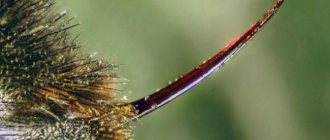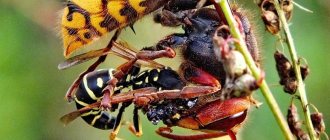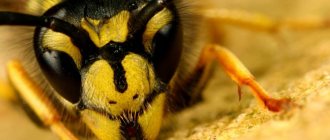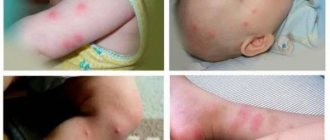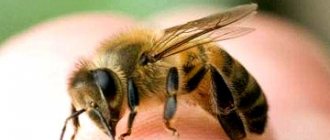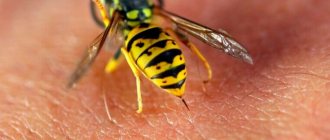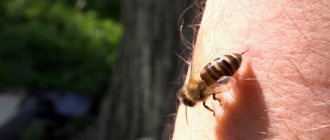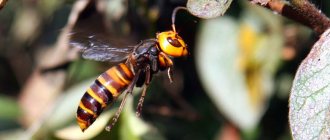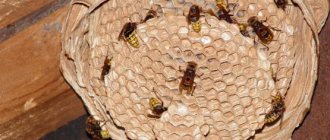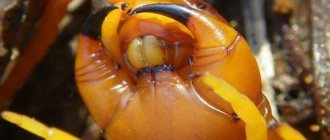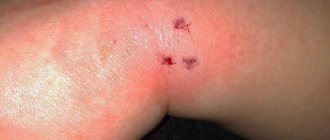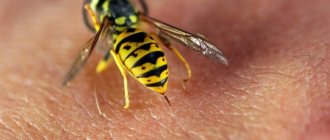Usually, when people see a bee flying up, they start to really panic. The first reaction that most people have is to drive away the dangerous insect by waving their arms. But is it right to act this way? What to do if an unpleasant incident could not be avoided? Why does a bee die after being stung?
If you are bitten by a bee, you do not need to wave your arms, run, or scream. The bite lasts 1–2 seconds, after which the insect tries to fly away immediately.
Does a bee die after stinging a person?
The bee, hornet and wasp have similar body structures, but they differ significantly. The bee dies after being stung, but nothing similar happens with other stinging insects. What is the reason for this feature? Why does a bee die after stinging? The point is the special structure of the sting, the tip of which resembles a hook. In case of danger, the insect can attack the enemy and attack in its characteristic way, by inserting a sting.
The bee does not always die after being stung. Human skin, like animal skin, is hard and elastic. When the sting hits it, the hook clings tightly inside. The frightened insect quickly twitches, trying to fly away. At this moment, the lower part of the body is torn off along with the sting, and the intestines of the attacking bee partially remain at the site of the bite. Damage to the insect's internal organs leads to death.
Other interesting questions and answers
What is the point of a bee sting if it dies after it?
Why then do you need to sting:
- self-defense? not very effective, because it will die anyway...
- destroying the offender so that he does not touch anyone else - so her bite is not fatal))
the sting remains in the victim. Why?
Let's start with the fact that a bee does not always die after stinging someone. This is true for those species of bees that are equipped with a special sting - with strongly pronounced serrations. Not everyone has this. African species, for example, have a rather smooth sting, so they can easily sting an enemy several times without dying.
Additionally, most bees we encounter are social animals. They live as a family - a swarm, in which one individual bee plays one clearly defined role. In some ways, a bee family can be compared with a caste society, but with a more rigid assignment of the role to an individual organism (at the physiological level).
Worker bees and the queen are “equipped” with a sting.
The uterus needs a sting, however, only at the very beginning - when it makes the mating flight to create a new family. She uses it to fight other females and, naturally, does not die from it.
It turns out that worker bees usually and most often sting. They are in the bee family - nurses, nannies, builders, security guards. They use their sting to protect the family (and, in fact, the uterus), the home and the supplies collected in it.
This is quite logical. - everything for the preservation of the species and the further existence of bees: the queen gives birth to future offspring, housing preserves them, food allows them to grow.
So it is precisely for the sake of protecting the future kind that the bee protects the family and stings the one who appears to be an enemy. She doesn’t care what exactly happens to this very enemy: he will simply run away, develop a “conditioned reflex” - not to approach this or other bee dwellings again and not touch the bees - or die from poison. The main thing is to leave him alone and not attack.
At the same time, the bee itself “does not think” about self-defense or about the consequences for it personally of such behavior. Simply because it is not actually a full-fledged living being (it is not even capable of reproducing, since it is sterile). Only the family as a whole exists as a complete organism. A worker bee is a component of this organism that performs a specific function; her death after performing this function (in this case, protection) for the family is not critical and does not matter.
An almost complete analogy to the behavior of a worker bee stinging an enemy is a lymphocyte - a blood cell whose purpose is to destroy foreign cells and microorganisms. By killing the “stranger,” lymphocytes themselves die, but provide the body as a whole with protection from various diseases. The body receives benefits (immunity, recovery), and its small part - the lymphocyte - in no way “thinks” about its own death and “does not regret”.
Why does a bee die after stinging?
The bee has a jagged stinger, similar to a jigsaw. Therefore, when bitten, it gets stuck in the body of the bitten person and, as they correctly wrote, is torn out of the bee with all its intestines.
And a wasp, for example, has a sting like a needle, not a saw, it doesn’t get stuck, so the wasp can bite without fear of dying.
Wow, I found a bee sting in magnification... Yu K 3
Is it possible to swallow a wasp (bee), if so, can it sting inside the body and if so, what will happen to a person?
It is possible to swallow a bee if, for example, it gets stuck in jam. She can also bite inside, this is fraught with swelling of the laryngeal mucosa, asphyxia and quick death from suffocation. Quite a lot of people die from a bite to the throat; they can only be saved by installing a tracheostomy within 10-15 minutes after the bite.
Lev Ovchinnikov 40
Mosquito Now I killed a big red mosquito, I saw that it had a sting in its ass, can this mosquito sting?
Not a single mosquito can sting - mosquitoes do not have stingers. And the big red mosquito was a harmless female Longlegged mosquito. You were afraid of her female organ - the ovipositor...
How long does a bee live after stinging a person?
Once a person is stung by the shoulder, death occurs within seconds.
The lifespan of a bee after stinging a person is only a few seconds. In the event of an attack not on people and animals, but on insects with a soft chitinous cover, there is a high chance of surviving by easily removing the sting after a bite.
A bee may not always use its weapon. If there is a lot of honey in its abdomen, then it is unlikely to sting.
How does a bee sting work?
The bodies of bees differ - their structure depends on the functions performed in the family, so queens, drones and workers have different anatomy. The sting can be up to 4.5 mm long. It is necessary for protection from other insects and animals. In case of danger, the bee sprays poison that causes burning and pain.
The sting, consisting of a fixed and movable section, is located on the bee's abdomen. In a calm state, it is hidden under the joint. This weapon is attached to the body and intestines with thin films for protection. The fixed section includes an unpaired middle part - a sled about 2.5 mm long, looking like a trench. Their front part widens slightly, and the back, on the contrary, narrows and ends with a sharp groove. In front of the sled, arched lateral processes diverge, between which there is a fork with sting muscles. Elongated plates are attached to the processes from above.
Bees and their structure vary depending on the duties they perform in the hive. In any case, an insect bite does not pose a threat to human health. The only exception is the presence of individual intolerance.
The movable section includes two styles - these are thin needles, at the end of which there are notches. The queen bee has 5 such notches, while the worker bee has 10. Along the entire length of the stylet there is a large longitudinal notch that extends onto the roller of the sled. Thanks to this connection of stylets and sleds, movement is carried out. The cavity formed by them is a channel through which the poison flows.
Get your sleigh ready for summer!
The ancient Mayans worshiped the god of bees, Ahmuzenkab. They had well-developed beekeeping traditions, especially a careful and respectful attitude towards bees. If it happened that during the work of the “beekeeper” an insect died, it was buried, having previously been wrapped in a leaf of some plant.
However, it is always better to save a dying person than to bury him with honors. The question arises: “Can a beekeeper prevent the death of his pets?”
The reasons for the mass death of “ladybirds” can be different, but the most critical moment is wintering. Therefore, proper preparation for it in advance is very important. Optimal temperature and humidity conditions in the hive and an adequate supply of food are the main conditions for preserving the bee colony in winter. And this is the beekeeper’s immediate concern!
You should always remember: if you have already tamed someone, you need to be responsible for him!
In what situations does a bee sting?
For those who plan to live in the country for a long time, this question is especially relevant. Bees use their weapons extremely rarely - only in exceptional cases, and not for attack, but for defense, when they encounter a serious threat. But there may be other circumstances:
- Strong smell. Sensitive olfactory receptors help to recognize the aroma of flowers over vast distances. An insect may attack if it senses something unusual and frightening - for example, the strong aroma of perfume or sweat.
- The smell of smoke. Instinctively, the insect senses danger, because such a smell may indicate a forest fire. Therefore, she tries to escape and in panic can sting everyone who meets on the way.
- Clothing in dark colors. Beekeepers note that bees react differently even to the color of clothing - dark shades cause aggression in them.
- Poison from other bees. If you are bitten by one bee, then others may attack - they will feel the poison, which will be a signal for an attack.
What to do if the insect sting remains in the wound: first aid
Wasps and hornets are the most aggressive insects and they can sting at the slightest provocation, at the slightest suspicion of their threat, unlike bees, which are much less aggressive and which most often sting when they are stepped on, sat on, accidentally grabbed or outright encroached upon to their home. The main sign of a bee sting, as mentioned above, is that it leaves a sting in the skin. The poison from the gland sac enters the human body for more than a minute. And the only sign of a wasp or hornet sting is the skin puncture point. After being stung by insects, the area around the wound quickly turns red and a seal forms around it under the skin (this collects fluid under the skin). It resolves after a few hours, but may remain itchy for more than 24 hours. Poisons injected when stung by insects vary in their chemical composition. Wasp venom is not alkaline, and bee venom is only slightly acidic. The chemical composition of these poisons is more complex than is believed, and therefore traditional treatment after a wasp sting with vinegar and a solution of soda after a bee sting brings only minor relief.
Bee sting
Bee's nest
When stung by a bee, it is necessary to remove the sting from the wound as quickly as possible to reduce the pain. This is done carefully, using tweezers, a knife or nails. The wound should be washed with soap and water. A cold compress, such as ice wrapped in a cloth, is then applied to the wound to reduce swelling. Ointments and balms, including anti-inflammatory and wound-healing ones, also help well after treating a wound (for example, rescue ointment and balm).
To reduce itching, you need to apply antihistamine cream to the stung area or take an antihistamine tablet orally. You can also use sunburn remedies to cool the wound and relieve itching. If the itching is very severe, then you need to see a doctor to get a steroid ointment. There may be more swelling around the wound. If the swelling is very large or does not go away for a long time, then you should definitely consult a doctor.
When should you call an ambulance?
You should immediately call an ambulance if any of the following symptoms appear after a sting:
- swelling around the throat, mouth, or tongue that makes breathing or swallowing difficult;
- wheezing, as well as shortness of breath or difficulty breathing;
- weakness, fainting, dizziness or headache;
- any chest pain;
- nausea, stomach cramps, vomiting.
Attention! It must be remembered that an allergy to poison can begin to develop at any time.
People who have been stung two or more times in recent years have the highest risk of developing allergies. There is also another risk group - those who suffer from other forms of allergies (to pollen, animal dander, etc.). You should also definitely call an ambulance in case of a massive insect sting, if it’s not just one or two stings, but a swarm.
How to avoid being bitten by stinging insects
People who are sensitive to stings need to take measures to help reduce the risk of being stung by insects:
- You should not wear bright clothes or use perfumes and deodorants with a strong aroma - they attract insects.
- Pants, long sleeves, shoes and hats should be worn.
- Repellents should be applied to exposed skin.
- Use candles or other insect repellent products.
- Do not leave sugary drinks or food products open - bees, wasps, and hornets will immediately fly towards them.
- Before you sit or lie down, you need to make sure that there are no stinging insects nearby.
- You need to avoid places where there are a lot of wasps, bees, and hornets, such as orchards and apiaries.
- When collecting fallen fruit from the ground, you must wear gloves.
- You should never crush wasps or bees - this increases the likelihood of stinging and attracting a swarm of these insects.
- You should not wave your arms and panic - this can also excite the insects, they will perceive it as aggression. If you are in a place where there are a lot of stinging insects, you need to calmly and slowly leave from there.
- If a wasp gets into the house, it should be sprayed with an insect killer spray; you should not try to catch it yourself with a rag or towel - the sting may pass through the fabric. A fly swatter can irritate the insect and it will defend itself by attacking.
- It should be remembered that wasps, hornets, and bees are afraid of water. In the event of a swarm attack, you can hide in the water, if there is a pond or containers with water of sufficient size nearby.
- If there are a lot of wasps or bees in the garden or house, there is probably a nest nearby. It is important to eliminate it as early as possible - wasps become very aggressive in late summer and it is much safer to remove their nest before this period.
Vespiary
Consequences of a bite
The best protection against insect bites is to prevent such a situation.
A single bite will not have a serious negative impact on the life of the victim if there is no allergy. Only a few minutes pass from the incident to the appearance of the first symptoms. At first, pain is felt at the site of the bite, the skin becomes red, and swelling appears. The sting must be removed quickly, otherwise a blister will appear in its place. Redness goes away relatively quickly - within a few hours, but swelling can last up to 10 days.
It is important to provide assistance to the victim in a timely manner to avoid unpleasant consequences. The sequence of actions is as follows:
- Do not allow the area of skin that has been affected to be scratched to avoid the rapid spread of poison.
- A cold compress or ice is applied to the bite site, and the victim is given medications with antihistamine properties.
- The affected skin is treated with a soap solution. You cannot squeeze out the sting that remains under the skin; you need to carefully remove it with disinfected tweezers.
- You can try to reduce the pain after extraction using traditional methods. To do this, make a paste from crushed leaves of parsley, plantain and boiling water. A compress of pre-chilled olive oil helps relieve itching and reduce redness. Aloe juice effectively relieves swelling.
Multiple bites pose a serious danger, especially for people prone to allergic reactions. With a first-degree allergy, hives appear, severe itching and swelling appear, and body temperature rises. With a second-degree allergy, the functioning of the respiratory system is disrupted, spasms in the intestines and arrhythmia are possible.
The most severe consequences occur if a bee stings you on the tongue. In this case, the poison rapidly spreads through the mucous membrane of the larynx, which leads to swelling and difficulty breathing. If poison gets into the eyes, swelling, redness and watery eyes may also appear.
If you have an allergy
Allergies in humans are caused by toxins contained in wasp venom near the sting. The main components of the poison:
- Acetylchodine, which disrupts the functioning of nervous tissue;
- Histamine is the main activator of inflammation and severe allergic reactions.
- Phospholipases are enzymes that destroy cell walls. Cause an inflammatory process;
- Hyaluronidase is a toxin similar to the previous enzyme.
- The hyperglycemic factor increases blood sugar.
Symptoms of an allergic reaction are:
- swelling, redness of the bite site and severe itching;
- fever, headache and shortness of breath;
- hives;
- confusion;
- anaphylactic shock.
It is because of anaphylactic shock and asphyxia that a person can die from a wasp sting. This phenomenon occurs very quickly - a few minutes after the sting. Seconds count; you need to call a doctor and provide first aid.
If anaphylaxis occurs, the victim should be given an injection of adrenaline or epinephrine and immediately call an ambulance. Do not leave the victim, lay him down and monitor his condition. If it does not improve, give a second injection of epinephrine. If you have trouble breathing, use an inhaler if available.
If after first aid a person feels better, but the doctor is already on his way, do not refuse hospitalization, it is necessary to prevent the recurrence of an allergic reaction.
Benefits of bee venom
Every product that bees produce is beneficial to humans.
Bee venom is no exception; it is used to relieve symptoms and treat various diseases. Bee venom is associated with painful sensations after a sting - burning and itching. But products made on its basis have a positive effect on the human body - nature has created many healing agents. Thus, thanks to the unique composition of bee venom, they increase hemoglobin levels, normalize blood clotting, lower blood pressure, and improve performance. The best effect can be achieved by combining the poison with useful health procedures - for example, sunbathing and swimming.
Who bites - female or male
Everyone knows that wasps sting, their bite causes pain and an allergic reaction. However, not all representatives of the wasp family bite. The sting is a modified ovipositor and is therefore only found in females. Males are harmless creatures that use only powerful jaws when fighting an enemy.
Since most of the aspen family are immature females, it appears that everyone bites. Males perform only a single function - they fertilize females in a certain period of time. They do not live long and die within a month. Females build a nest, find food, feed offspring, and protect the hive.
At the end of summer, a young generation of males and sexually mature females - queens - appear. The mating season begins. At this time, wasps are the most aggressive and dangerous and are found almost everywhere. In August-September the entire swarm leaves the nest and scatters around the area. With the onset of cold days, workers and drones die, young fertilized females hide in the wood and hibernate.
Wasp sting
Methods of treatment with bee venom
Treatment can be carried out in different ways. Patients are given subcutaneous injections, ointments based on bee venom, and special baths are prescribed. Bee stinging is popular. It is important to carry out any procedures only as prescribed by an apitherapist, as there are many contraindications.
Bee venom is actively used in medicine for:
- vascular diseases;
- migraines;
- hypertension of the first and second degrees;
- intercostal neuralgia.
How can a person avoid a bee sting?
In order to minimize the risk of a bee sting, do not make sharp sounds near the apiary, remember that insects can react aggressively to the strong odors of perfume, powder and other products.
To avoid becoming a target for insects, it is better to follow simple rules:
- Do not use perfume in your summer cottage, so as not to attract bees with a strong aroma.
- In places where bees are likely to appear, it is better to wear light-colored clothing.
- Do not eat sweets or drink sugary drinks in possible places where bees appear, and also do not leave half-eaten fruits at your summer cottage in the summer.
- Try not to make sudden movements when you see a bee, so as not to scare it.
How to provide first aid and what to do after being stung by a bee, watch the video.
Now you know why a bee dies after stinging, and also how long a bee lives after stinging a person. You should not be afraid of single bites if you are not allergic to the venom of these insects. Try to follow simple safety rules and a dangerous incident is unlikely to happen. But if a peace-loving summer resident or city dweller is nevertheless attacked by a bee, then you should calmly provide first aid, information about which is presented step by step in this article.
What affects life expectancy
In order for insects to have a quality life, beekeepers need to take care of their apiary quite intensively. It is necessary to pay attention to the creation of the following conditions:
- Providing high-quality feeding if the number of honey plants is insufficient.
- Ensuring proper wintering conditions.
- Inspect the family at every time of the year for possible diseases and pests that can intensively weaken the immunity of the entire nest.
- Providing the required amount of honey plants - if they are not in the area, then it may be necessary to take out the apiary, providing the required amount of food and collected honey.
The life of bees in a hollow, as well as wasps, is approximately a quarter longer than those that live in hives. The following factors influence how long wild bees live in nature:
- There is no human factor - no one takes away food.
- It is the lack of selection of reserves that forces insects to work less, and, accordingly, their body wears out less.
- In wild individuals, the body's protective immune forces work more efficiently.
- The factor where the wasps and wild representatives live also plays a role. They select the most optimal places to reduce negative climatic and weather factors.
- Brood is produced in a smaller volume.
